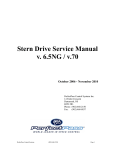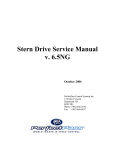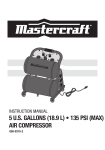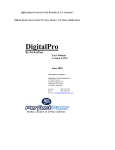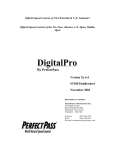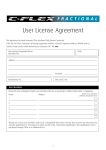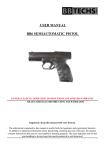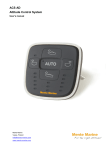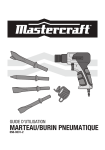Download WAKEBOARDPRO
Transcript
WAKEBOARDPRO Version 6.5N January 2005 Information or assistance: PerfectPass Control Systems Inc. 218 Wright Avenue Burnside Industrial Park Dartmouth, Nova Scotia CANADA B3B 1R6 By phone (902) 468-2150 By fax (902) 468-8837 By email [email protected] Table of Contents Page Number User’s Guide Section 1 Section 2 Section 3 Section 4 Using WakeboardPro Wakeboard Mode Slalom Mode RPM Mode Driving Tips 1 2 3 4 Display Features / System Settings General Information Quick List 5 7 Troubleshooting Common Questions & Answers Linkage Test / Servo Motor Test 8 10 Installation Instructions 11 Warning: PerfectPass highly recommends you become familiar with the operation of your new boat prior to using the speed control. (Leave in OFF position). Once you are familiar and comfortable with the operation and handling of your boat, try the speed control in the different modes without a skier to familiarize yourself with its operation. If you feel it is not working properly or have questions, leave in the OFF position and contact PerfectPass or your dealer immediately. Section 1. Using WakeboardPro There are three operating modes to choose from: (1) Wakeboard mode controls from the paddlewheel speed sensor and allows the user to set a desired speed; (2) RPM mode allows the user to set an rpm control value, and (3) Slalom mode allows for recreational slalom skiers to enter a speed for open water skiing (24 – 36 mph). The ON/OFF key is pressed to turn control ON or OFF. System should always be OFF when not using speed control. Turning system ON / OFF must always be done with boat in neutral or at idle for safety reasons. Before towing a rider / skier with WakeboardPro, practice without anyone in tow to familiarize yourself with system operation. If you feel the system is not operating properly or have questions, leave control OFF and contact PerfectPass or your dealer. When you are ready to tow a rider, with boat in neutral turn control ON. Screen will ask you to confirm boat is in neutral by pressing UP key. This will appear as [ IN NEUTRAL ^ = Yes ]. Typically, most wakeboarders prefer the pull characteristics of the Wakeboard mode. This mode has been designed for the 15 – 25 mph range. For open water skiing or if using the speed control at speeds above 25 mph, the RPM mode or Slalom mode is recommended. Wakeboard Mode In this mode, the screen will appear as follows: System Off OFF 20.0 Set Speed System On 0.0 Actual Speed WAKB D 20.0 Set Speed 0.0 Actual Speed Select the desired operating set speed by pressing the UP or DOWN keys. Pull the rider up normally and accelerate smoothly up to or slightly beyond the target speed. Once PerfectPass sees the actual speed reach the set speed it will automatically take control and will notify you of this with an audible beep. (Underlines will appear during engagement). While in control, WakeboardPro should hold a smooth steady speed in a straight course down the lake. The driver should keep their hand on the throttle for safety, and to prevent it from pulling back on its own which will cause PerfectPass to disengage. To Disengage System: If the rider falls simply slow boat down which will disengage speed control. Return to rider slowly and pull up again. System will once again take over when target speed is reached. Speed Changes: Speed changes can be made prior to pulling up a rider or on the fly. 1 Turns / Over-riding the system: As the boat enters a turn, the engine rpm may increase to keep the craft at the set speed. If the driver would like less throttle (so the rider does not get whipped) then simply pull back some on the throttle and help the system maintain a safe speed. As you complete the turn, move the throttle gently forward and the system will regain control. (The driver can override the system at any time by pulling back, or advancing the throttle). The digital speed readout should be checked & calibrated at 20 mph & again at 28 mph. See “Digital Speedometer Adjust” on page 5. To move from Wakeboard mode to Slalom mode, simply press MENU key twice and the following will appear: [ WAKBD SPD ^ = slm ]. Press UP key to enter Slalom mode. Slalom Mode This mode allows you to set speeds in 2 mph increments ranging from 24 – 36 mph. This mode is designed for those wishing to use the system for open water skiing. System Off OFF System On 00 Tachometer 0.0 Actual speed SL32 00 Set Speed Tachometer (Slalom 32 mph) 0.0 Actual speed The set speed is changed by pressing the UP or DOWN keys, which can be done on the fly. The tachometer is shown in the center and actual boat speed is shown on the right. Slalom Calibration Step 1:Calibrate Speedometer - Although a speed is selected, the speed is actually being controlled via rpm so an initial “Digital Speedometer Adjust” is required. This calibration is done at 20 & 28 mph in Wakeboard mode and must be done prior to calibrating RPM baselines. See “Digital Speedometer Adjust” on Page 5. Step 2:Calibrate RPM Baseline – Initial calibration of baselines should be done with 2 – 3 people in boat and without a skier. If you set the speed at 32 mph, but your digital speed readout shows something different such as 31, simply press the MENU key on the fly to enter the Slalom Calibration Screen. In this example, the actual speed is only 31 so the rpm in the center of screen must be raised. Press the UP key several times and the rpm baseline will increase 25 rpm per press. This will increase the rpm on the boat which will increase the actual speed. Adjust the rpm until the actual speed matches the set speed. MENU will take you back to main screen. Set Speed (Slalom 32 mph) R=32 3200 Baseline RPM 31.0 Slalom Calibration Screen Actual Speed 2 Step 3:Change speed and repeat Step 2 until all desired slalom speeds have been calibrated. Note: Each slalom speed must be adjusted independently to the correct rpm. If you are towing skiers, you can change the set speed on the fly (ie. 30-32), or you can raise the rpm baseline setting on the fly by pressing MENU. For example, you have 32 mph set, but because you have five people in the boat, the speed may be running a little slow due to the extra weight. You can adjust the speed by entering the slalom calibrate screen and raising the rpm baseline until the digital speedometer matches the desired speed. (This Slalom mode is for recreational skiing and will provide an excellent, tournament quality pull, however, it is not designed to be as accurate as a tournament class speed control). Press MENU key twice and the following will appear: [ SLALOM ^ = rpm ]. Press UP key to move to RPM mode. RPM Mode In this mode, the screen will appear as follows: System Off OFF 00 Tachometer System On 0.0 Actual Speed 2800 Set RPM 00 Tachometer 0.0 Actual Speed Operating in this mode is very similar to using the Wakeboard mode, except the system is controlling to a set rpm, 2800 in this case. Prior to towing the rider / skier, select the rpm set point by using the UP or DOWN keys. Pull the rider up smoothly and continue to accelerate up to or beyond the set rpm point so the system can take control. Rpm changes can be made on the fly to fine tune the rpm. When you have finished using PerfectPass, return to neutral and press the ON/OFF key. Press MENU key and the following will appear: [ RPM ^ = wkb ]. Press UP key to move to Wakeboard mode. 3 Driving Tips: 1. Always pull a rider up smoothly. If you accelerate too far past the target speed, you can gently pull the throttle handle back to assist PerfectPass in taking control. When PerfectPass engages you will hear an audible “beep”. In addition when engaged some of the characters on screen will become underlined. 2. Always leave your hand on the throttle and keep an eye on the lake ahead. Pull back throttle to neutral to stop boat. (The system will immediately disengage and the boat will be under manual control). 3. When returning to a rider in the water, drive very slowly and carefully. Always turn engine off when loading or unloading a rider from platform. Never back a boat up when someone is in water behind. 4. The speed based mode is not designed for skiing & speeds over 25 mph as the control may not be smooth. RPM or Slalom mode is designed for smooth control over 25 mph. 5. “More throttle” If you see the # sign on the screen, this means PerfectPass is running out of control room, press throttle handle slightly ahead until the # disappears. 6. You can temporarily over-ride the system by applying more throttle. The engine speed will increase for about 5 seconds before PerfectPass regains control. 4 Section 2. Display Features / System Settings Every time you turn ignition on, the Display will return to the last mode & speed (or rpm) that was used. You do not need to turn control OFF prior to turning off boat ignition, but it is recommended that when you are finished using the system that it be placed in the OFF mode. When in OFF mode, the display remains active and digital speedometer will continue to read. The servo motor is powered, but is locked in OFF position. The tachometer will continue to read when in RPM or Slalom mode. Moving through Menu – To move from mode to mode, simply press MENU key until you see the prompt. In this example [WAKBD SPD ^ =slm] you are in the Wakeboard mode, press the UP key to move to Slalom mode. Quick List - To enter the list to recall a Rider’s Name & speed, press MENU & UP keys together. For details on establishing names, see Page 7. Lake Temperature - To view lake temperature press MENU & UP keys together, then press the MENU key once. When the system is set to read in kph, then temperature will be in degrees Celsius. Note: If temperature does not appear, feature is unavailable for your boat Hour Meter - To view hour meter press MENU & UP keys together, then press MENU key until engine hours appear. If engine hours cannot be found then this feature has been disabled and is not present on your system. The hour meter counts when rpm is detected by the Master Module, and is not RESET to “000” after ‘system reset’. Calibrate Lake Temp - To calibrate lake temperature press the UP & DOWN keys together when temperature is being displayed. Battery Voltage - To view battery voltage press MENU & UP keys together, then press the MENU key once or twice (depending if lake temperature is present). Digital Speedometer Adjust (Calibrate) - If you believe the system is not controlling at an accurate speed, by pressing the MENU key, while in Wakeboard mode you can access [SPEEDOMTER ADJST]. Example: You have the system set and engaged at 20 mph, but you believe the boat is actually traveling at 23 mph. While engaged, access [SPEEDOMTER ADJST] via MENU key, then press the DOWN key until the boat slows by 3 mph. Run the boat and fine tune if necessary. All wakeboard speeds should now be accurate. (A hand held GPS is ideal for confirming accuracy). You should check and calibrate the speed in Wakeboard mode at 20 mph and again at 28 mph for accuracy. 5 KdW (Pull Characteristic) - If you wish to change this control parameter, turn OFF control in Wakeboard mode, then press UP & DOWN keys together. KdW can be changed using the UP or DOWN keys. Higher values = more aggressive control response. Factory setting is 80. (Example: Heavily loaded boats may need a higher value to maintain a steady, crisp pull. Try 100 – 150). After adjustment, press MENU to proceed. (Maximum recommended setting 200). NN (Paddle Filtering) - This follows KdW and represents the filter factor of the paddlewheel. Typical values 120 – 160. Higher values mean the system will sample more revolutions prior to making a speed adjustment. If you feel the system should be “smoother” try increasing the NN. This parameter only affects the operation of Wakeboard mode. 6 Using the Personalized Screen – “Quick List” AMANDA 20.0 20.5 This version of WakeboardPro allows you to store up to eight names and their preferred speed. These can then be accessed via the “Quick List” (MENU & UP keys together). Creating Names – While in neutral, press MENU & UP keys together and [QUICK LIST ^ = Yes] will appear. Press UP key and [ MENU = list ^ = new ] will appear. You will press UP key to enter new names, MENU key to access names already entered. If you press UP key to enter new name, [ NEW ENTRY ^ = Yes ] will appear. Press UP key to enter new name. Screen will then appear as follows depending on mode you are in. Mode cannot be changed while entering a name. You must be in the mode you want before creating name. Mode _ Name (6 characters) wkb 20.0 Preferred Speed Scroll through the alphabet using UP & DOWN keys, and then press MENU to move to next position. When the name & speed have been set, exit via MENU key and entry will be saved. Selecting Names – Press MENU & UP keys together to access [ QUICK LIST ^ = Yes ]. Press UP key and then MENU key to enter list. Once in the list, the MENU key is used to scroll through list. Once the name is on screen you wish to select, press the UP key. Editing List – As you scroll through the list of names, instead of pressing UP key to select that name, press the DOWN key to edit. The mode cannot be edited. Note: Names can be changed by ‘Editing List’ but can only be deleted by performing ‘System Reset’ (ON/OFF & MENU on startup), or by performing a ‘Partial Reset’ (MENU & DOWN on startup). All names will be deleted. 7 Section 3. Troubleshooting Common Questions & Answers Condition: In both Wakeboard & RPM mode the system beeps to engage, but boat speed never settles in and “hunts” above & below Set Speed. Solution: It appears that the PerfectPass throttle cable does not have free movement and is rubbing against engine cover or some other obstacle. A Linkage Test should be performed. See Page 10. Condition: System beeps to confirm engagement, but boat continues past set speed and never locks in. Solution: Computer is attempting to control, but servo not responding. A Servo Motor Test should be performed. (Servo motor could be seized). See Page 10. Condition: System “hunting” in Wakeboard mode only. RPM mode working perfectly. Solution: 1. Inspect paddlewheel for damage. Does it spin freely? 2. Is paddlewheel fully seated in housing? Is arrow pointing forward? Condition: PerfectPass digital speed reading shows 22 mph, but GPS indicates boat speed is actually 24 mph. Solution: Press MENU key once while in Wakeboard mode and [SPEEDOMTER ADJST] will appear. Quickly press DOWN key several times and drop calibration speed by 2 mph. (Can be done in the shop or on the water). Remember, the LCD screen simply shows the data from Master Module so there is no reason to suspect the Display is a problem. Condition: PerfectPass green light in display is on, but no data on screen. Solution: Check to see if servo motor is powered, if not then the system does not have adequate voltage or is poorly grounded and will not start. (Measure voltage on PerfectPass power cable, which should be in excess of 12 V). Note: When ignition is OFF, the black knob on servo motor turns easily. When powered, knob is stiff and is difficult to turn by hand. If servo motor is powered and performs auto tighten rotation but Display has no data, then Display should be changed. 8 Common Questions & Answers (Cont’d) Condition: PerfectPass has no digital speed reading. Solution: 1. Check Master Module to ensure paddlewheel cable is properly connected and pins are in proper position and not bent. 2. Does paddle spin freely? 3. If all looks well, perform a “System Reset”. Condition: UP key on Display does not respond. Solution: Make sure all 10 pins on Master Module are in-line where display connects. If connection is OK, key pad switch is faulty, return to PerfectPass for repair. Condition: Boat speed drops and throttle handle must be pushed far down to get acceleration. Solution: Servo motor is not holding and rotating properly usually due to a bad connection at the servo motor. See Servo Motor Test, page 10. Condition: System is blowing the 5 amp, 1.25” fuse on 12 V power cable. Solution: Generally caused by a short or “grounding” problem with the red 12 V power cable on servo motor. Closely inspect wiring particularly around gold resistor. (Remember, resistor & servo motor will run very hot which is normal). Condition: Speed in Slalom mode not accurate. Solution: Did you go into Calibrate by pressing MENU key once in Slalom mode? This screen allows you to adjust an RPM baseline up or down so speed is more accurate. If you believe the PerfectPass digital speedometer is not accurate, see “Digital Speedometer Adjust” on Page 5. 9 LINKAGE TEST This test should confirm whether the PerfectPass throttle cable & linkage connection is properly working. With key OFF, turn black knob on servo motor in clockwise direction until snug. (This is the normal start position of the knob). It should always return to this position when returning to neutral. Now push the manual throttle to 1/2 open position. Now take black knob on servo and slowly turn the knob in a counterclockwise direction, and then in a clockwise direction. As you rotate the knob back & forth, you should see the throttle lever on engine opening & closing very smoothly with each step of the motor. As you turn the knob counterclockwise which lets out cable, the throttle will close back towards neutral. When you rotate it clockwise the throttle will open. As you rotate the knob back and forth (slowly and quickly), the throttle should open & close very smoothly and the brass L Adapter at linkage should be rotating as well to follow cable. At no point should the throttle cable catch, hook or come into interference with any part that could disrupt the cable movement. If the cable is rubbing against a decorative engine cover, fuel rail, motor box etc, adjust servomotor and cable to improve alignment. Many plastic decorative engine shrouds can cause this problem. Remove temporarily and run boat if you suspect this could be a problem. Final Test: With key OFF, push manual throttle to full open position. Watch PerfectPass throttle cable to ensure it can move freely without binding or interference. Throttle Return Spring: PerfectPass can open the throttle (by turning clockwise), but relies on the engine return spring to close the throttle when the servo turns counterclockwise. (The return spring is always applying pressure against the throttle back towards the neutral position). If the servo turns counterclockwise to slow the boat, but the throttle lever on engine does not move or moves very slowly, the return spring could be weak, broken, etc. If you feel the spring is weak or damaged, an external return spring can be added. Servo Motor Test / Auto Tighten Test Every time you return the boat to neutral when PerfectPass is on, the servo will wind in the cable until snug in a clockwise direct. This is the normal starting point for the servo. Each time you turn the key on or start the boat, PerfectPass becomes powered and the servo will perform an “auto tighten” function and will attempt to wind in the cable to confirm it is in normal position. (If in proper position, it will appear simply as a “click”, “click”, “click”). To check servo & servo power wire, with key off turn black knob on servo motor counter clockwise _ of a turn. Now turn key on and black knob should turn clockwise about _ of a turn as part of auto tighten. If it does, repeat procedure, except this time hold black knob gently to apply some resistance to auto tighten. If it rotates with good strength then it would appear servo & servo power cable are fine. If it does not rotate or just vibrates, then a wiring phase coming to the servo may be loose or broken. Inspect all wiring around servo. Pull both white plugs apart at servo & inspect pins to ensure they are in place. Gently tug on each wire to ensure they are securely in crimp. Check at Master Module where cable is connected. If you cannot locate problem, contact PerfectPass. Important Notes: 1. The gold resistor will run extremely hot. This is normal. 2. If system is new, make sure servo power cable is plugged into Master Module correctly and not upside down. Tips on plug should point up towards label on Module. 10 Section 4. Step 1. Installation Instructions PerfectPass Wakeboard Pro Installation of Servo Motor Using the two provided hose clamps, loosely mount the servo motor on top of the cooling water hose leading to drivers side exhaust manifold (starboard side on standard inboard engines). See Figure A. Tighten later after final positioning. (See amended installation details “Photo” if inserted for certain engines for servo motor mounting position). Remove ball joint connector from throttle control lever and remove from the coupling end of Morse control / Teleflex cable. (See Figure B). Position servo motor throttle cable in line with the throttle control lever. Ensure the locking 10/32 nut is in place on Morse control / Teleflex throttle cable. Screw threaded brass hex connector on the PerfectPass cable onto the end of the Morse control throttle cable. (Do not over tighten hex nut). Install L shaped brass throttle adapter to throttle control lever using identical hole as original ball joint. (L adapter must be able to swivel). Using an Allen key, tighten L shaped adapter mounting bolt. (See Figure C). You may find it helps to move the Morse control lever into gear during installation to allow more clearance. (Be sure the washer is against the brass L-Adapter and not under the nut). Check and adjust position of servo motor ensuring the motor box cover closes properly and servo throttle cable is not in contact with any moving parts. Make sure servo motor cable has 2 or 3 inches of free travel. Securely tighten hose clamps on servo motor. (Do not “tie wrap” cable as it must be able to move freely). With the throttle in neutral position, adjust brass hex connector if necessary to ensure there is no gap between it and the end of the servo motor cable (any gap may cause engine to surge up and down in neutral). Adjust and snugly tighten all parts. (See photo’s, DO NOT OVER TIGHTEN). Turn the black servo motor knob in a clockwise position until snug. With throttle in neutral, the linkage should appear as in Figure C. Linkage Test – This is a quick & easy test to check throttle cable & linkage. With key OFF, push throttle lever to _ open position. Now take the black knob on servo motor and wind it counter clockwise a full turn and then clockwise a full turn. Do this slowly in each direction and as you do this the engine throttle arm should be opening and closing very smoothly. If the cable is “rubbing” or “catching” on a fuel rail or decorative engine cover, the servo & cable should be repositioned to eliminate this. The stainless cable inside the black jacket MUST be able to seamlessly move for the control to work properly. With key off, push manual throttle to full open position and back to neutral. PerfectPass cable should move freely in both directions. IMPORTANT: - Step 2. Never “tie wrap” PerfectPass throttle cable. Make sure all wires are tied away from hot or moving parts and there is adequate clearance. The manual throttle on your boat should operate and feel the same as before the PerfectPass was installed, or you may have to adjust the hex nut. Installation of Master Module Mount the Master Module under the dash normally on the bulkhead accessible behind and right of the passenger seat in a dry location. It can also be installed on the left side of driver’s bulkhead. The wires from under the dash pod can be easily fed across the bulkhead. 11 Route servo motor power cable from Master Module to servo motor and connect. (Use tie wraps to keep cable away from moving parts). Make sure the tips on the plug are facing up towards the top of the Master Module box. A wire snake will be helpful. Step 3. Mount Dash Display Remove the right speedometer (if boat has two speedometers) or remove tachometer and install the In Dash PerfectPass Display and connect into Master Module. (If there is a speedo tube on back, it should be clamped). Step 4. Connect Power Wire Depending on the boat and model, there are a number of ways to connect to a switched (12 volt) power source. 1. 2. 3. 4. 5. Step 5. On boats with traditional analogue gauges and posts on back of tachometer, there is a 12 volt (+) post often marked (IGN) which is an easy connection to the purple wire. The black wire end can attach to the ground (-) post marked (GND). On boats with Borg Warner gauges with no posts, attach the PerfectPass purple power wire to the purple wire leading to the ignition terminal. The black wire can be securely grounded to the grounding bar or other suitable ground location. 2000 - 2004 Nautiques – There is a main wiring harness and large white plug located behind the dash pod. Connected to this plug is a purple wire carrying the switched 12 volts and a black wire which is a suitable ground connection. 2002 – 2005 MasterCraft – Power, RPM and Paddle Wheel speed is all located in the special plug and play harness supplied with each system. The MasterCraft supplied white connector is on every boat specifically for PerfectPass. You may have to remove the driver’s foot panel to locate this connector in the boat’s wiring harness. 2005 Malibu – There is a plug & play harness for speed, RPM and Power. RPM Cable Installation This connection will depend on the brand and year of boat you own. (1) Standard Installation (Older boats and boats with traditional Analogue gauges with Posts on back) The Gray wire with ring terminal can be easily attached to the “SEND” post on back of tachometer. This Gray wires picks up the raw engine rpm from this post. The Black wire ring terminal can be attached to any suitable ground, including the ground post on the tachometer. (If there is not a post, connect to the solid gray wire coming from the tachometer). (2) 2002 - 2005 MasterCraft – The custom wiring harness supplied by PerfectPass allows for plug & play for RPM, Power & Paddle Wheel. (3) 1998- 2004 Malibu (Borg Warner Gauge System) In behind the dash pod on most models, Malibu has left a Gray (RPM) wire that terminates at a large female spade connector. If you can locate this, you can simply attach the Gray wire on the rpm sensor cable to this connector. Alternatively, you can locate the solid gray wire in the main wiring harness that leads into the Borg Warner control box under the dash. Use a blue “Tee Tap” connector to connect to this gray wire. You can then attach the gray rpm sensor wire to this using a push on spade connector. The black wire can be securely connected to any suitable ground. LS-1 On this engine (pre 2002 only), you only connect the Black wire on the RPM Sensor cable to the Gray wire leading to the Borg Warner control box. (same as LT-R MasterCraft). The gray RPM sensor wire is left un-connected. 12 2005 Malibu – See plug & play harness. (4) 1999 – 2001 MasterCraft, 2000 Supra, 2000-2002 Infinity (All Other Brands Using Borg Warner Gauges) TBI & Multi Port Engines (except LT-R) – Locate the solid gray wire in the main wiring harness that leads from the engine into the Borg Warner control box under the dash. This solid gray wire carries the raw engine rpm. Use a blue “Tee Tap” connector to connect to this gray wire. You can then attach the gray wire on the rpm sensor to this using a push on spade connector. The black wire can be securely connected to any suitable ground. LT-R / LT-1 - On this engine the Gray wire lead on the PerfectPass RPM Sensor cable is not used and can be taped off. The separate Black wire end must be connected to the Gray wire located in the main wiring harness leading into the Borg Warner MDC Control box. It is on the engine side of the box that the raw rpm is located. You can attach a blue “Tee Tap” connector to this Gray wire, and attach the RPM sensor cable end to this “Tee Tap” using a supplied spade connector. (5) 2000 – 2002 Nautiques Same as standard #1 above, except the rpm signal can be picked from the Gray wire coming from the back of the tachometer. (6) 2003 - 2005 Nautiques Located behind the dash pod is a large wiring harness with a large white plug. The Gray wire in this plug carries the raw rpm of the engine and has been brought to the pod solely for the PerfectPass system. This gray wire is not connected to any gauge. Use a blue “Tee Tap” connector or other splice method to attach the gray wire on the PerfectPass rpm sensor cable to this Gray wire in the harness. The Black wire (ground) on the RPM Sensor cable can be attached to the black wire in this same boat harness. Step 6. Install Paddle Wheel speed sensor and connect to Master Module. (See attached detailed instructions). Note: On most late model boats, a paddlewheel is already standard so PerfectPass did not supply a second paddlewheel. Step 7. Test system power by turning on key. Following a short delay the black servo knob should be difficult to turn indicating system is powered. A final and easy test to ensure servo motor and cabling is working properly is to turn key OFF, then turn the black knob on servo motor counter clockwise by _ of a turn. Now turn key ON and system should perform an “Auto-Tighten” function and wind cable in a clockwise direction until tight. (If motor does not wind in, but simply vibrates for 5-6 seconds, the servo power cable at Master Module may be plugged in upside down or a connector at servo motor may be damaged. (Pull plugs apart and inspect pins). For assistance call (902) 468-2150. 13 Installation and Setup Instructions for PerfectPass Paddlewheel System – ST300 Paddlewheel Tools and Material Required 2 inch hole saw, Sealant eg. GE silicone sealer Installation The 2-inch hole is placed approximately 6-7 inches (16 - 18 cm) perpendicular to the centerline of an inboard ski boat, beside the drain plug under the engine. (See below for v-Drive location). Never install behind a strake, depth sounder, etc. Normally this is on the passenger side away from the bilge pump and other cables etc. Ensure there is sufficient room to pull the inner paddlewheel assembly from the housing when it is mounted under the engine. In this area of the bottom of the hull there is normally a flat surface away from the turbulence of the tracking fins and lifting strakes. The hole saw is used to cut the hole for the paddlewheel working from the bottom of the boat. (You may wish to drill a pilot hole with a drill bit from the inside to make it easier to locate from underneath) Before disassembling the paddlewheel unit take note of the arrow on the bottom of the housing and on the top of the inner paddlewheel assembly near the cable exit, these arrows both point forward when the unit is installed. Disassemble the paddlewheel unit by unscrewing the locking cap until it is completely free to turn, then pull complete assembly up and separate from housing. Take care not to loose the paddlewheel itself and its stainless steel shaft, which maybe free when the unit is disassembled. Remove housing nut and rubber ring gasket. (This gasket will be installed later on the inside of boat). The sealant must be placed on the surface of the sealing flange on the housing and also on some of the lower threads of the housing to help lock the sealing nut in place. The bottom of the hull in the area of installation must be clean and dry for the sealant to seal properly; inside the bilge should also be clean to allow the seal nut to be properly tightened. Install housing from below boat with the arrow on the bottom surface of the housing pointed toward the forward direction of travel of the boat, parallel to the keel of the boat. Install gasket and seal nut should be tightened snugly by hand so that the sealant is forced out of the sealing surface and the housing flange is as close as possible to the hull surface. The excess sealant must be wiped away from the housing to give the water flow a clear path. A final check of the location of this directional arrow and inside notch in housing should be made before the sealant is allowed to setup. Reassemble the paddlewheel unit by sliding the inner unit into the housing with the arrow on the inner housing pointing toward the front. (Ensure paddlewheel assembly is properly centered in “notch” of housing, with arrow pointing toward bow). Hand tighten the locking cap. The output cable should be run under the floor with the servo power cable so that it can be plugged into the master module. (Included with this unit is a “Plug” and extra paddle and axle kit.) V-DRIVE / WAKEBOARD BOATS / STERN DRIVES – The paddle is typically installed in front of the engine, just behind the gas tank. (This area is generally accessible from the engine compartment or under rear seat.) It is installed typically 7 – 8 inches off center, clear of any strakes in the hull, depth sounders, etc. Refer to any addendums that may be included. Never install behind a water intake or any other item that could cause turbulence. The key to a good installation is to place the paddle in a location where there is nothing to disturb the flow of water in front of the paddle for 5-6 feet. 14 WARNING RELEASE OF LIABILITY – ASSUMPTION OF RISK IMPORTANT (Detach, sign and mail immediately) YOU MUST READ THIS! The PerfectPass Speed Control device is a high performance mechanism designed solely for use with water ski and wakeboard boats operating under ideal, calm conditions utilizing a spotter and all other safety crew and requirements of tournament water skiing. The PerfectPass Speed Control device should not be used for any other purpose or under any other conditions. YOUR USE OF YOUR PERFECTPASS SPEED CONTROL DEVICE IS CONDITIONAL UPON YOU ASSUMING ALL RISKS, LOSSES AND DANGERS RELATING TO USE OF THIS DEVICE. Both purchaser and/or anyone utilizing the PerfectPass Speed Control device acknowledges that their purchase and or use of this device is conditional upon them releasing and forever discharging PerfectPass Speed Control Systems Inc., its directors, officers, employees, agents and/or dealers, their heirs, and assigns from any and all liability for personal injury or property loss and from any other claims, demands, losses or causes of action, whether occurring prior to, during, or subsequent to or directly or indirectly connected with the use of the PerfectPass Speed Control device, and whether caused by any persons negligence or otherwise. The PerfectPass release of liability, and warranty agreement shall be interpreted in accordance with the laws of the Province of Nova Scotia, Canada, and IT IS FURTHER AGREED that any legal proceedings that either directly or indirectly relate to the PerfectPass Speed Control device shall be conducted within the Province of Nova Scotia, Canada, regardless of where arising. The purchaser hereby agrees to inform any subsequent purchasers or anyone using the PerfectPass Speed Control device, of the conditions of this Release of Liability, Assumption of Risk Agreement. It is agreed that there shall be absolutely no alterations to this agreement whether by implication or otherwise. ___________________________________________ Purchaser Signature __________________________________ Date ______________________________________________________ Address ____________________________________ ____________________________ Serial Number (found on Master Control Module) ____________________________________ Name (Please Print) (Must be signed to affect valid purchase and activate warranty agreement, detach and mail immediately to PerfectPass Control Systems Inc., 218 Wright Avenue, Dartmouth, Nova Scotia, B3B 1R6, Canada). LIMITED WARRANTY During the first 12 months from date of original retail purchase, any PerfectPass component that fails due to defects in materials or workmanship will be repaired or replaced at the option of PerfectPass at no charge. All warranty claims must be authorized in advance and a Return Authorization (R/A #) issued. All packages, correspondence, documents and packing slips must reference this R/A #. Warranty excludes components damaged my improper installation or improper use of boat. Servo Motors are water resistant, but not water proof. Servo motors may become damaged if excess water is run in a boats bilge and this may void warranty. Ensure your boat is properly “bilged” prior to operating. Warranty Service: 1. If your PerfectPass was factory installed, any warranty issues should be directed to your authorized dealer. PerfectPass encourages all customers to contact us prior to visiting your dealer for “technical support” as many issues may be easily handled direct with customer. 2. If your PerfectPass was purchased and installed by a dealer you may contact your dealer direct or initiate a warranty claim with PerfectPass. 3. If your PerfectPass was purchased directly from the Company, contact us at the number below. Warranty Service / Technical Support PerfectPass Control Systems Inc. 218 Wright Ave. Dartmouth, Nova Scotia CANADA B3B 1R6 (902) 468-2150 (Hours: Monday to Friday, 8:00 am – 4:00 pm EST)


















